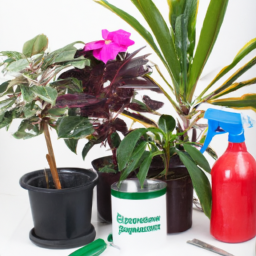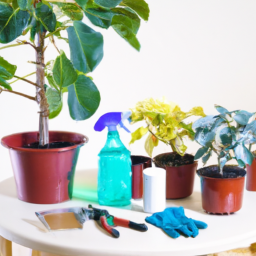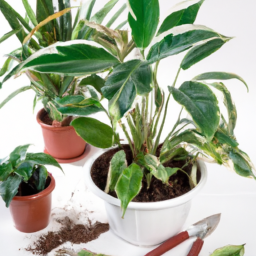
Winter is a time when we often find ourselves cozying up indoors, surrounded by our beloved houseplants. As we spend more time with them, we may start to notice signs of root-bound pots or plants that could benefit from a fresh potting mix. However, a common question that arises during this season is, “Can I repot indoor plants in winter?” Well, fear not fellow plant enthusiasts, because in this blog post, we will explore the ins and outs of repotting indoor plants during the colder months. So, grab a cup of hot cocoa, settle in, and let’s dive into the world of winter repotting!
The Importance of Repotting Indoor Plants in Winter
Winter can be a challenging time for indoor plants. With the lack of sunlight and lower temperatures, they tend to slow down their growth and become dormant. However, this doesn’t mean that you should neglect them completely. In fact, repotting your indoor plants during winter can be a beneficial practice that helps them thrive and stay healthy. In this article, we will explore the importance of repotting indoor plants in winter and provide you with a step-by-step guide on how to do it effectively.
Why Repot Indoor Plants in Winter?
Repotting indoor plants in winter offers several advantages. Firstly, it allows you to refresh the soil and remove any accumulated salts or mineral deposits. Over time, the soil in the pot can become compacted and lose its ability to drain properly. By repotting, you provide your plants with fresh, well-draining soil that promotes healthy root growth.
Secondly, repotting gives you an opportunity to inspect the roots of your indoor plants. During the winter months, root growth is slower, making it easier to handle and examine the root system. This allows you to identify and address any potential issues such as root rot or overcrowding. By repotting, you can trim damaged roots and give your plants a fresh start.
Lastly, repotting indoor plants in winter can help stimulate new growth once spring arrives. By providing your plants with fresh soil and a slightly larger pot, you give them the necessary nutrients and space to grow. This can result in healthier and more vigorous plants when the growing season resumes.
Step-by-Step Guide to Repotting Indoor Plants in Winter
Now that we understand the importance of repotting indoor plants in winter, let’s dive into the step-by-step process:
Step 1: Choose the right time
When deciding to repot your indoor plants, it’s crucial to choose the right time. Winter is generally a good time as the plants are in their dormant phase. However, make sure to avoid repotting during extremely cold periods or when your plants are showing signs of stress.
Step 2: Select the appropriate pot
When selecting a new pot for your indoor plant, choose one that is slightly larger than the current pot. This allows room for the roots to grow without overwhelming the plant. Ensure that the pot has drainage holes to prevent waterlogging, which can lead to root rot.
Step 3: Prepare the new pot and soil
Before repotting, prepare the new pot by cleaning it thoroughly and covering the drainage holes with small stones or a mesh screen. This prevents the soil from escaping while still allowing excess water to drain. Use a high-quality potting mix that is well-draining and suitable for indoor plants.
Step 4: Gently remove the plant from its current pot
Carefully remove the plant from its current pot by gently tapping the sides and bottom. If the plant is stuck, you can use a knife or a small trowel to loosen the edges. Avoid pulling the plant forcefully, as it can damage the roots.
Step 5: Inspect and prune the roots
Once the plant is out of its pot, inspect the roots for any signs of damage or overcrowding. Trim any brown or mushy roots using clean scissors or pruning shears. If the roots are tightly wound, gently tease them apart to encourage outward growth.
Step 6: Place the plant in the new pot
Position the plant in the center of the new pot and fill the surrounding space with fresh potting mix. Gently press the soil down to eliminate any air pockets and ensure good root-to-soil contact. Avoid burying the plant too deep, as this can lead to stem rot.
Step 7: Water and settle the plant
After repotting, give your plant a thorough watering to help settle the soil and hydrate the roots. Allow any excess water to drain out completely before placing the plant back in its usual spot. Avoid overwatering during the winter months, as the plant’s water requirements are reduced.
Step 8: Provide appropriate care
Once repotted, continue to care for your indoor plant as usual. Place it in an area that receives adequate light for its specific needs. Adjust your watering schedule based on the plant’s requirements and the drying time of the new potting mix. Monitor the plant closely for any signs of stress or issues.
By following these step-by-step instructions, you can successfully repot your indoor plants in winter and promote their overall health and growth. Remember to choose the right time, select an appropriate pot, prepare the new pot and soil, gently remove the plant, inspect and prune the roots, place the plant in the new pot, water and settle it, and provide appropriate care.
Repotting your indoor plants in winter may require some effort, but the benefits are well worth it. Your plants will thank you with lush foliage and vibrant blooms once spring arrives.

Best Practices for Repotting Indoor Plants during the Winter Season
Winter is a challenging time for indoor plants, as they often experience changes in lighting, temperature, and humidity. However, repotting your indoor plants during this season can still be done successfully if you follow some best practices. In this article, we will guide you through the process of repotting indoor plants in winter, ensuring that your plants stay healthy and thrive despite the seasonal challenges.
Choosing the Right Time
Before you dive into repotting your indoor plants, it’s important to choose the right time. Winter is generally not the ideal season for repotting, as plants are in a dormant phase and may be more sensitive to changes. However, if your plant is showing signs of being root-bound or if it’s necessary for its overall health, repotting can still be done.
It’s best to choose a mild winter day with stable indoor temperatures for repotting. Avoid repotting during extremely cold or frosty days, as sudden temperature changes can shock your plants. Additionally, aim to repot your plants in the morning when they are naturally more active and have ample time to recover during the day.
When repotting during winter, it’s crucial to ensure that the new potting mix is warm. Cold potting mix can negatively impact your plant’s roots and slow down their growth. To warm up the potting mix, you can place it in a warm room or near a heat source for a few hours before repotting.
Preparing the Plant and Pot
Once you’ve chosen the right time for repotting, it’s essential to prepare both the plant and the pot. Start by gently removing the plant from its current pot, being careful not to damage the roots. If the plant is root-bound, you may need to loosen the roots slightly to encourage new growth.
Inspect the roots for any signs of rot, disease, or pest infestation. If you notice any issues, take the necessary steps to address them before repotting. Trim away any damaged or dead roots using clean and sharp pruning shears.
Next, choose a new pot that is slightly larger than the current one. Make sure the pot has drainage holes to prevent waterlogging, which can lead to root rot. Clean the pot thoroughly to remove any debris or pathogens that may harm the plant.
Repotting Process
Now that your plant and pot are prepared, it’s time to proceed with the repotting process. Follow these steps to ensure a successful repotting during the winter season:
Step 1: Add a layer of drainage material: Place a layer of small stones or broken pottery shards at the bottom of the pot. This will help improve drainage and prevent water from accumulating at the roots.
Step 2: Add fresh potting mix: Fill the pot with fresh potting mix, leaving enough space for the plant’s roots. Use a high-quality potting mix that is suitable for your plant’s specific needs. Avoid using garden soil, as it can be too heavy and may contain pests or diseases.
Step 3: Position the plant: Gently place the plant in the new pot, ensuring that it is centered and at the desired height. The top of the root ball should be slightly below the rim of the pot to allow for watering without overflowing.
Step 4: Fill the gaps: Carefully fill the gaps between the plant’s roots and the potting mix with more potting mix. Use your fingers or a small tool to gently press the mix around the roots, ensuring they are well-supported.
Step 5: Water thoroughly: After repotting, give your plant a thorough watering. This will help settle the potting mix and remove any air pockets around the roots. Allow excess water to drain out completely before placing the plant back in its usual spot.
Step 6: Provide proper care: After repotting, it’s important to provide your plant with the right care. Place it in a suitable location with appropriate lighting and temperature conditions. Avoid exposing the plant to cold drafts or direct heat sources. Monitor the soil moisture and adjust your watering schedule accordingly.
Remember that repotting can be stressful for plants, especially during the winter season. It’s normal for them to take some time to adjust to their new environment. Be patient and observe your plant closely for any signs of stress or decline. With proper care and attention, your indoor plants will adapt and continue to thrive throughout the winter season and beyond.

How to Safely Repot Indoor Plants in Winter without Damaging Them
Winter can be a challenging time for indoor plants, as they may suffer from various issues like root congestion, nutrient deficiency, or even pests. Repotting your indoor plants during winter can help them thrive and ensure their overall health. However, it’s crucial to follow the right steps to avoid any damage to your beloved plants. In this article, we will provide you with a step-by-step guide on how to safely repot indoor plants in winter.
1. Choose the Right Time
The first step in safely repotting indoor plants in winter is to choose the right time. It’s important to wait for a mild winter day when the temperature inside your home is stable. Avoid repotting during extremely cold days or during sudden temperature fluctuations, as it can shock the plants and hinder their growth. Aim for a day when the weather is calm and the indoor temperature is consistent.
Before you begin, gather all the necessary materials such as a new pot, fresh potting mix, gardening gloves, and a watering can. Make sure the pot you choose has proper drainage holes to prevent waterlogging and root rot.
Prepare the new pot by cleaning it thoroughly and filling it with fresh potting mix suitable for your plant’s specific needs. This will provide the necessary nutrients and aeration for healthy root growth.
2. Prepare Your Plant
Before removing the plant from its current pot, water it thoroughly. This will help loosen the soil and make it easier to remove the root ball without causing damage. Keep in mind that it’s essential to avoid overwatering, as damp soil can lead to root rot.
Gently tap the sides of the pot to loosen the root ball. If the plant is tightly rooted, use a clean knife or gardening tool to carefully loosen the edges. Be cautious not to damage the roots or the plant’s stem.
Once the root ball is loosened, carefully lift the plant from its current pot, holding it by the base of the stem. Avoid pulling the plant from its leaves or stems, as this can cause breakage or damage.
3. Repotting Process
Place a layer of fresh potting mix at the bottom of the new pot, ensuring it covers the drainage holes. This will help with proper drainage and prevent soil from escaping through the holes.
Next, gently place the plant’s root ball into the new pot, making sure it sits at the same level as it did in the previous pot. Fill the remaining space around the roots with fresh potting mix, gently pressing it down to eliminate any air pockets. Avoid compacting the soil too tightly, as it can hinder water absorption and root growth.
Once the repotting is complete, water the plant thoroughly until water drains out from the bottom of the pot. This will help settle the soil and ensure proper hydration. Dispose of any excess water accumulated in the drainage tray to prevent waterlogging.
Finally, place the repotted plant in a suitable location where it can receive adequate light and maintain a stable temperature. Avoid placing it near drafty windows or heat sources, as sudden temperature changes can stress the plant.
It’s important to note that after repotting, plants may experience a period of adjustment. Keep an eye on your plant’s condition and provide appropriate care, including regular watering and monitoring for any signs of stress or disease.
By following these steps, you can safely repot your indoor plants in winter without causing any damage. Remember to choose the right time, prepare your plant properly, and follow the repotting process carefully. With proper care and attention, your indoor plants will continue to thrive even during the winter months.
Here are the Essential Points
Winter is a time when many of us hunker down indoors, seeking warmth and comfort. As we cozy up in our homes, we may notice that our indoor plants need a little TLC. One question that often arises during this season is whether it’s okay to repot indoor plants in winter. Well, the good news is that with a few considerations, it is possible to repot your leafy companions even when the weather outside is chilly.
First and foremost, it’s important to assess the specific needs of your plant. Some plants, like succulents, prefer to be left undisturbed during winter, as they enter a period of dormancy. However, for other houseplants that are actively growing, repotting can be beneficial. The key is to choose the right time and provide the right conditions. If you decide to repot, make sure you do it early in the season before the plant’s growth slows down. Additionally, ensure that the new pot is only slightly larger than the previous one, as a drastic change in pot size can stress the plant. By following these guidelines and providing the necessary care, you can give your indoor plants a fresh start and help them thrive throughout the winter season.
Frequently Asked Questions (FAQ):
Q1: Can I repot indoor plants in winter?
A1: Yes, you can repot indoor plants during winter, but it’s generally recommended to avoid doing so unless necessary. Winter is a period when plants are in a state of dormancy, and disturbing their roots by repotting can cause stress and hinder their ability to recover.
Q2: Are there any exceptions to repotting indoor plants in winter?
A2: Yes, there are exceptions. If your indoor plant has outgrown its current pot and is root-bound, or if there are signs of plant health issues like root rot or pest infestation, repotting may be necessary even during winter. In such cases, it’s important to proceed with caution and provide extra care to help the plant adjust to its new environment.
Q3: What precautions should I take when repotting indoor plants in winter?
A3: When repotting indoor plants in winter, it’s crucial to ensure the new pot has proper drainage to prevent waterlogging. Use a well-draining potting mix suitable for your plant’s needs. Avoid overwatering, as plants tend to require less water during their dormant period. Place the repotted plant in a location with appropriate lighting and temperature conditions for its specific species.
Q4: Can repotting indoor plants in winter help them thrive?
A4: Repotting indoor plants in winter can potentially help them thrive if done correctly and if the plant truly needs repotting. It allows for root growth and provides fresh nutrients and soil. However, it’s important to consider the specific needs of your plant and evaluate whether repotting is necessary or can be postponed until the growing season when plants are more actively growing.
Q5: What if I can’t repot my indoor plants in winter?
A5: If repotting is not feasible or recommended during winter, there are alternative steps you can take to ensure the health of your indoor plants. You can gently remove any dead leaves, provide adequate light exposure, adjust watering frequency based on the plant’s dormant state, and monitor for any signs of stress or disease. It’s always best to prioritize the well-being of your plants and make decisions based on their specific needs.

James Wong is a renowned ethnobotanist, plant scientist, and local television presenter. With a passion for demystifying plant science, he is known for translating complex botanical concepts into practical advice for everyday plant enthusiasts. James’s expertise spans from traditional gardening to cutting-edge plant technologies, making his insights accessible and informative.


